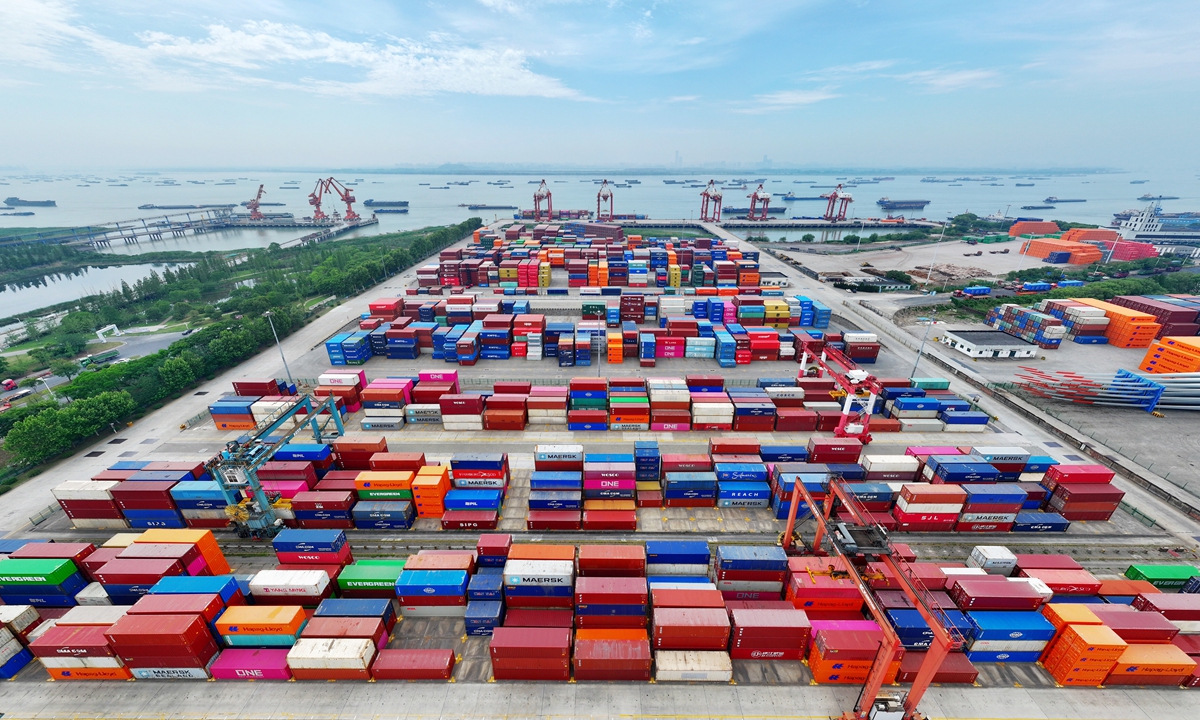
An aerial drone photo shows cargo ships and containers at a terminal of Yangzhou Port in East China's Jiangsu Province on May 14, 2025. Photo: IC
Shares in China's shipping sector continued their strong performance on Monday, with some major firms' shares hitting the daily limit for a fifth consecutive day amid surging demand following recent China-US trade talks in Geneva.
On Monday, shares in Jiangsu Lianyungang Port Co, Ningbo Marine Co and Nanjing Port Co all rose by the daily limit for a fifth consecutive day. Shares in Zhuhai Port Co and Ningbo Zhoushan Port Co surged by more than10 percent, hitting their limit-up thresholds."The rise in shipping-related stocks reflects increased purchasing activity by US companies following the outcome of the China-US trade talks a week ago, as they rush to stockpile goods during the 90-day tariff suspension window," Zhao Nan, an expert at the Shanghai International Shipping Research Center, told the Global Times on Monday.Businesses rushing to clear backlogs from the earlier period of high tariffs is another major factor driving current market sentiment, experts said."When US tariffs peaked at 145 percent on April 9, many shipments bound for the US came to a standstill. After the tariffs were eased on May 14, a backlog effect emerged — a large volume of goods previously held up at Chinese ports needed to be shipped, triggering a surge in outbound shipments," Zhong Zhechao, founder of One Shipping, an international logistics consultancy, told the Global Times on Monday.Uncertainty about what will happen after the 90-day tariff suspension is also fueling the rush to ship goods to the US, as companies aim to avoid potential future costs or disruptions, according to industry experts.Traditionally, the peak season for China-US trade runs from July to September, as businesses prepare for major shopping events in the US in the second half of the year, such as Thanksgiving, Black Friday and Christmas.However, due to uncertainty about what will happen after the 90-day window, many US companies are placing orders and shipping earlier to ensure their goods arrive within the current window, Zhong said.Shipping from China to the US typically takes between 30 and 45 days, depending on the route and port. When factoring in order placement, production and delivery, the timeline is already quite tight, industry analysts said.An analyst at Huayuan Securities told the Securities Times on Monday that a surge in shipments on transpacific routes, triggered by the 90-day China-US tariff pause, is expected to push both volumes and freight rates higher.Additionally, regional shipping rates in Asia may be lifted by the spillover effects, potentially boosting the performance of related firms, the analyst said.Yao Shuai, a representative of Shipco Transport (Shanghai) Shenzhen Branch, has come to better understand just how eager his US clients are to have goods delivered as quickly as possible to make up for delays caused by the tariffs imposed before the joint statement by China and the US.Before the joint statement, the company's shipments from China to the US dropped by about 70 percent. At the same time, the frequency of shipping vessels, container availability and air freight capacity fell about 60-70 percent, as some carriers such as shipping lines and airlines suspended services when they couldn't fully use their capacity, Yao told the Global Times.However, after the tariff pause, Yao predicted that in the coming weeks, cargo from China to the US will crowd shipping routes, pushing freight volumes higher and driving up shipping costs significantly, noting that outbound shipments are waiting for ships to come to Chinese ports.Following the significant reduction in China-US tariffs, a Maersk representative said that the company "has seen an increase in cargo bookings," and it will increase capacity on the China-US route to meet rebounding market demand.On the US side, some ports are also reportedly expecting an increase in cargo volumes. According to vessel tracking data, cargo imports at the Los Angeles port are expected to increase by 21.98 percent week-on-week from May 18-24, the National Business Daily reported on Monday."Adjustments to China-US shipping routes and shipping capacity were already in progress, but the surge in restocking demand from the US amid future uncertainty over US trade policy has significantly accelerated the pace," Zhao said. "This growing demand is also clearly reflected in rising port volumes."
